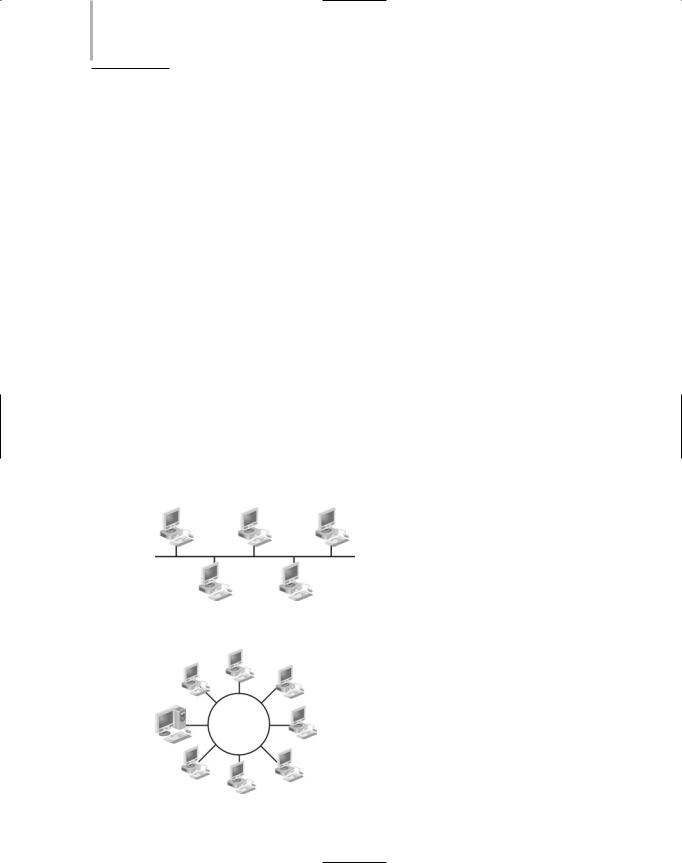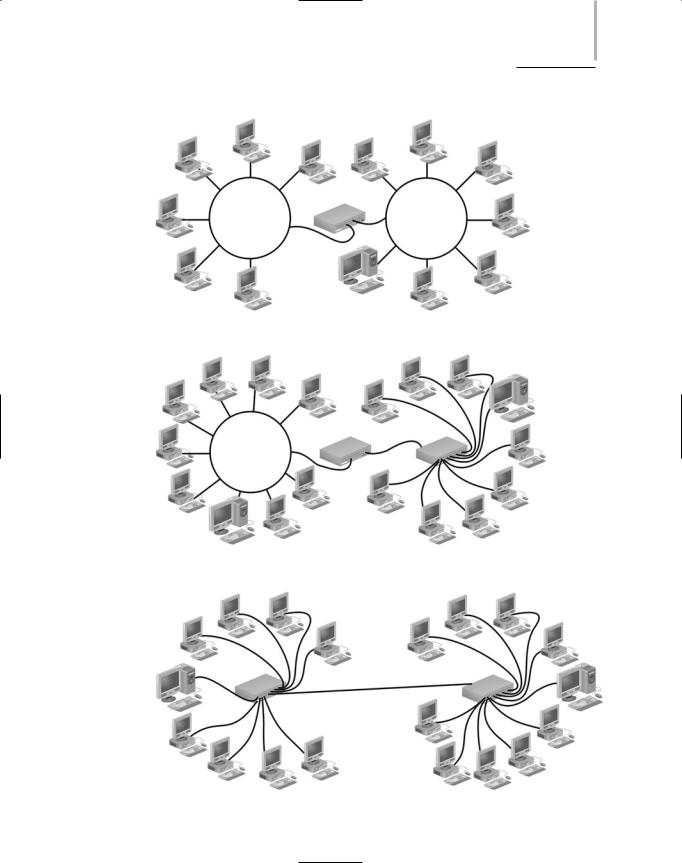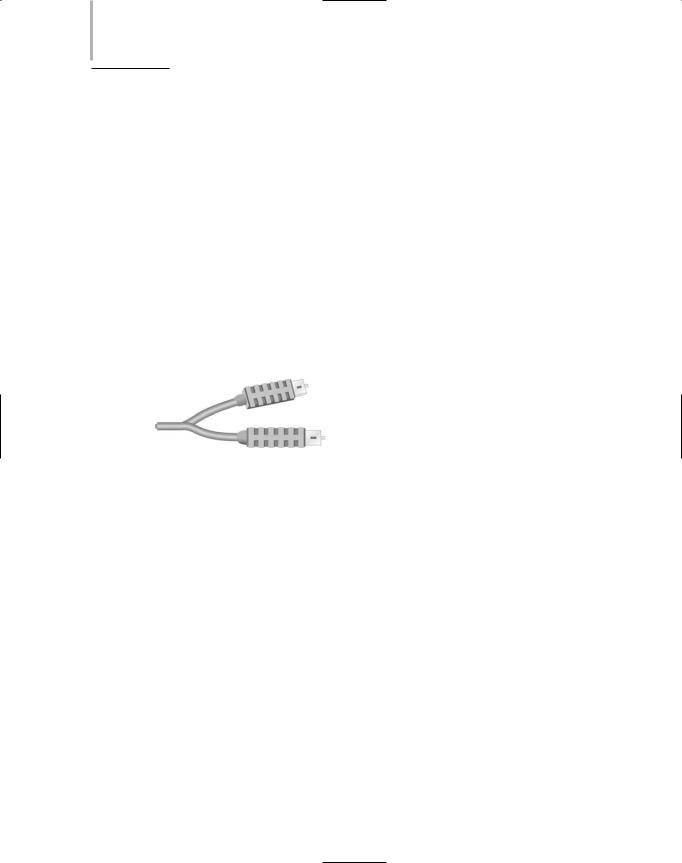
Network Plus 2005 In Depth
.pdf
712 Appendix A NETWORK+ EXAMINATION OBJECTIVES
Table A-3 Network+ Examination Objectives—Network Implementation
Objective |
Chapter |
|
3.4 |
Given a remote connectivity scenario comprised of a protocol, an |
|
authentication scheme, and physical connectivity, configure the connection. |
|
|
Includes connection to the following servers: |
|
|
|
UNIX / Linux / MAC OS X Server |
4, 8, 9, 10 |
|
Netware |
4, 8, 9, 10 |
|
Windows |
4, 8, 9, 10 |
|
Appleshare IP (Internet Protocol) |
4, 8, 9, 10 |
3.5 |
Identify the purpose, benefits and characteristics of using a firewall. |
14 |
3.6 |
Identify the purpose, benefits and characteristics of using a proxy service. |
14 |
3.7 |
Given a connectivity scenario, determine the impact on network |
|
functionality of a particular security implementation (For example: port |
|
|
blocking/filtering, authentication and encryption). |
14 |
|
3.8 |
Identify the main characteristics of VLANs (Virtual Local Area Networks). |
5 |
3.9 |
Identify the main characteristics and purpose of extranets and intranets. |
11 |
3.10Identify the purpose, benefits and characteristics of using antivirus software. 13
3.11Identify the purpose and characteristics of fault tolerance:
Power |
13 |
Link redundancy |
13 |
Storage |
13 |
Services |
13 |
3.12 Identify the purpose and characteristics of disaster recovery: |
|
Backup / restore |
13 |
Offsite storage |
13 |
Hot and cold spares |
13 |
Hot, warm and cold sites |
13 |
|
|

DOMAIN 4.0 NETWORK SUPPORT Appendix A 713
Domain 4.0 Network Support—
35% of Examination
Table A-4 Network+ Examination Objectives—Network Support
Objective |
Chapter |
4.1 Given a troubleshooting scenario, select the appropriate network utility from |
|
the following: |
|
Tracert / traceroute |
11 |
ping |
4, 11 |
arp |
4 |
netstat |
11 |
nbtstat |
11 |
ipconfig / ifconfig |
4, 11 |
winipcfg |
11 |
nslookup / dig |
11 |
4.2 Given output from a network diagnostic utility (For example: those utilities |
|
listed in objective 4.1), identify the utility and interpret the output. |
4, 11 |
4.3 Given a network scenario, interpret visual indicators (For example: link |
|
LEDs (Light Emitting Diodes) and collision LEDs (Light Emitting Diodes)) |
|
to determine the nature of a stated problem. |
5 |
4.4 Given a troubleshooting scenario involving a client accessing remote |
|
network services, identify the cause of the problem (For example: file services, |
|
print services, authentication failure, protocol configuration, physical |
|
connectivity and SOHO (Small Office / Home Office) router). |
7, 12 |
4.5 Given a troubleshooting scenario between a client and the following |
|
server environments, identify the cause of a stated problem: |
|
UNIX / Linux / Mac OS X Server |
9, 12 |
Netware |
10, 12 |
Windows |
8, 12 |
Appleshare IP (Internet Protocol) |
8, 12 |
4.6 Given a scenario, determine the impact of modifying, adding or removing |
|
network services (For example: DHCP (Dynamic Host Configuration Protocol), |
|
DNS (Domain Name Service) and WINS (Windows Internet Name Service)) |
|
for network resources and users. |
4, 12 |

714 |
|
Appendix A NETWORK+ EXAMINATION OBJECTIVES |
|
|||
|
|
|||||
|
|
|
|
|
|
|
|
|
|
Table A-4 Continued |
|
||
|
|
|
|
|
|
|
|
|
|
Objective |
Chapter |
||
|
|
|
|
|
|
|
|
|
|
4.7 Given a troubleshooting scenario involving a network with a particular |
|
||
|
|
|
physical topology (For example: bus, star, mesh or ring) and including a |
|
||
|
|
|
network diagram, identify the network area affected and the cause of the stated |
|
||
|
|
|
failure. |
6, 12 |
||
|
|
|
4.8 Given a network troubleshooting scenario involving an infrastructure (For |
|
||
|
|
|
example: wired or wireless) problem, identify the cause of a stated problem |
|
||
|
|
|
(For example: bad media, interference, network hardware or environment). |
4, 12 |
||
|
|
|
4.9 Given a network problem scenario, select an appropriate course of action |
|
||
|
|
|
based on a logical troubleshooting strategy. This strategy can include the |
|
||
|
|
|
following steps: |
|
||
|
1. |
Identify the symptoms and potential causes |
12 |
|||
|
2. |
Identify the affected area |
12 |
|||
|
3. |
Establish what has changed |
12 |
|||
|
4. |
Select the most probable cause |
12 |
|||
|
5. |
Implement an action plan and solution including potential effects |
12 |
|||
|
|
|
6. Test the result |
12 |
||
|
7. |
Identify the results and effects of the solution |
12 |
|||
|
8. |
Document the solution and process |
12 |
|||
|
|
|
|
|
|
|

Appendix B
Network+
Practice Exam
The following exam contains questions similar in content and format to what you will encounter on CompTIA’s Network+ certification exam. The exam consists of 65 questions, all of which are multiple choice. Some questions have more than one answer, and some questions require that you study a figure to determine the right answer.The questions are in no particular order.The number of questions on each topic reflects the weighting that CompTIA assigned to these topics in their 2005 exam objectives. If you want to simulate taking the CompTIA Network+ certification exam, you should allow yourself 90 minutes to answer all of the questions.

716Appendix B NETWORK+ PRACTICE EXAM
1.What TCP/IP utility would you use to determine the number of hops between two routers?
a.FTP
b.Nslookup
c.Nbtstat
d.Tracert
e.Telnet
2.You are the network administrator for a NetWare 6.5 network that runs the TCP/IP protocol. A new user in your organization can log on to the NetWare server, but cannot retrieve her spreadsheet files.Which two of the following situations could be the cause of her problem?
a.She has entered the wrong user name or password.
b.She does not have permission to read files in the directory where the spreadsheets are stored.
c.Her network cable is not inserted into her workstation’s NIC.
d.She does not have permission to view files on the volume where the spreadsheets are stored.
e.The DHCP settings in her workstation’s TCP/IP configuration are incorrect.
3.Which of the following figures reflects the type of physical topology commonly used on a 100BASE-TX network?
a.
b.

NETWORK+ PRACTICE EXAM Appendix B 717
c.
d.
e.

718Appendix B NETWORK+ PRACTICE EXAM
4.You have connected to your bank’s home page. Its URL begins with “https://.” Based on this information, what type of security can you assume the bank employs for receiving and transmitting data to and from its Web server?
a.Kerberos
b.SSL
c.IPSec
d.L2TP
e.packet-filtering firewall
5.You are a support technician for an ISP (Internet service provider) called Alpha Enterprises. A new customer calls to ask why his dial-up connection to your company’s RADIUS access server won’t work. After the user double-clicks the ISP dialup networking connection icon on his Windows XP desktop, you can hear his modem dialing. And even though another machine seems to answer, his connection never gets established.You verify that his phone line is connected properly and that he has entered the correct phone number.You also make sure he is using the correct, casesensitive user name and password that he just received from your Customer Service Department.What do you ask him to check next to get closer to solving his problem?
a.the type of server specified in his Alpha Enterprises Properties dialog box
b.the version of Windows XP his system uses
c.whether the “Save Password” check box is checked in his Connect to Alpha Enterprises dialog box
d.whether he has disabled the call waiting feature in his Alpha Enterprises Properties dialog box
e.the maximum baud rate his modem can handle
6.Which of the following protocols is not routable?
a.RIP
b.NetBEUI
c.TCP/IP
d.IPX/SPX
e.AppleTalk
7.Which of the following best describes the function(s) of the MAC sublayer?
a.It performs data compression, reformatting, and encryption.
b.It appends a node’s physical address to frames before they’re transmitted.
c.It interprets program requests and requirements to provide an interface between applications and the network.

NETWORK+ PRACTICE EXAM Appendix B 719
d.It manages flow control, and issues requests for retransmission of data that has suffered errors.
e.It translates network addresses into their physical counterparts and determines routing.
8.You are a networking technician in a radiology clinic, where physicians use the network to transmit and store patients’ diagnostic results. Shortly after a new wing, which contains X-ray and magnetic resonance imaging (MRI) machines, is added to the building, computers in that area begin having intermittent problems saving data to the file server. After you have identified the symptoms, what is your next step in troubleshooting this problem?
a.Determine the number of workstations affected, to which segment the affected workstations belong, and which area of workstations is affected.
b.Notify colleagues in the clinic’s IT Department about a change you are going to make while attempting to resolve the problem.
c.Research the problem on your NOS vendor’s technical support Web site.
d.Identify recent changes to the network to determine whether a hardware or software change may be responsible for the problem.
e.Identify the potential effects of the solution you are about to apply, to make sure that you do not inadvertently create new problems.
9.Which two of the following media are capable of providing the foundation for a Fast Ethernet network?
a.Level 1 UTP
b.CAT 2 UTP
c.CAT 5 UTP
d.RG-58A/U coaxial cable
e.fiber-optic cable
10.In which of the following situations would a crossover cable be useful for troubleshooting a network connectivity problem with a workstation?
a.to connect the workstation to a hub
b.to connect the workstation’s hub port to a punch-down block
c.to connect the workstation to another workstation
d.to connect the workstation’s switch port to its hub port
e.to connect between the workstation’s wall plate and its hub port

720Appendix B NETWORK+ PRACTICE EXAM
11.Which of the following WAN topologies is the most fault-tolerant?
a.full mesh
b.bus
c.peer-to-peer
d.ring
e.hierarchical
12.Which of the following is a valid MAC address?
a.C3000000FFFF
b.111.111.111.111
c.::9F53
d.AEFFG0930110
e.D0000000
13.What type of network could use the type of connector shown below?
a.100BASE-FX
b.100BASE-TX
c.10BASE-T
d.10BASE-5
e.10BASE-2
14.Your organization has just ordered its first T1 connection to the Internet. Prior to that, your organization relied on a DSL connection.Which of the following devices must you now have that your DSL connection didn’t require?
a.modem
b.CSU/DSU
c.switch
d.hub
e.MAU

NETWORK+ PRACTICE EXAM Appendix B 721
15.What type of addresses do bridges read, and to which layer of the OSI Model do bridges belong?
a.IP addresses; the Network layer
b.IP addresses; the Transport layer
c.MAC addresses; the Network layer
d.MAC addresses; the Data Link layer
e.IP addresses; the Data Link layer
16.You have been asked to provide a connectivity solution for a small, locally owned franchise of a national restaurant chain.The owners of the franchise want to send their confidential sales figures, personnel information, and inventory updates to the national office, which is 1200 miles away, once per week.Their total monthly data transfer will amount to almost 50 megabytes.The franchise owners do not plan to use the connection for any other purposes, and they do not have any IT staff to support the connection. Also, they do not want to spend more than $75 per month, nor more than $500 to install their connection. Considering cost, speed, reliability, technical expertise, distance, security, and the nature of their environment, what is the best solution for this client?
a.a T1 that connects to the national office via a router at the local franchise and a router at the national office and that uses IPSec to ensure the security of the data en route
b.a PSTN connection to a local Internet service provider that uses PPP to dial into an access server, then sends data via e-mail to the national office
c.a DSL connection to a local telephone and Internet service provider that uses IPSec to encrypt the data before it is sent to the national office’s file server over the Internet
d.a private SONET ring to connect with two local telephone and Internet service providers that connects to the national office’s T3 and sends data via TCP/IP over ATM
e.an ISDN connection to a local Internet service provider that allows you to copy files to the national office’s anonymous FTP site
17.IEEE’s Physical layer standards for wireless networking are established by which IEEE committee?
a.802.3
b.802.5
c.802.11
d.802.2
e.802.7
